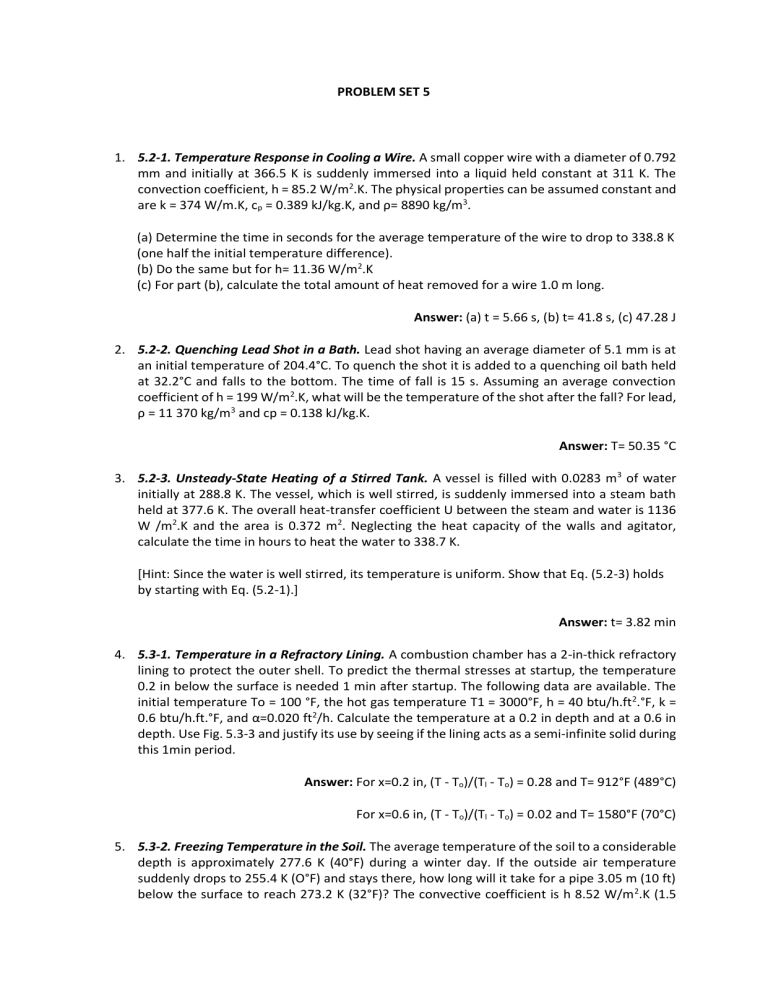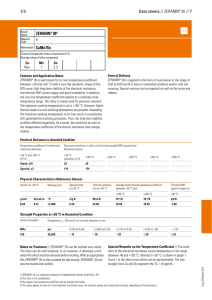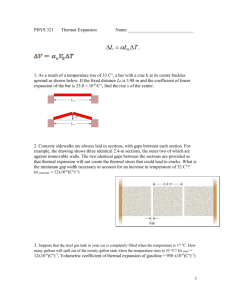
PROBLEM SET 5 1. 5.2-1. Temperature Response in Cooling a Wire. A small copper wire with a diameter of 0.792 mm and initially at 366.5 K is suddenly immersed into a liquid held constant at 311 K. The convection coefficient, h = 85.2 W/m2.K. The physical properties can be assumed constant and are k = 374 W/m.K, cp = 0.389 kJ/kg.K, and ρ= 8890 kg/m3. (a) Determine the time in seconds for the average temperature of the wire to drop to 338.8 K (one half the initial temperature difference). (b) Do the same but for h= 11.36 W/m2.K (c) For part (b), calculate the total amount of heat removed for a wire 1.0 m long. Answer: (a) t = 5.66 s, (b) t= 41.8 s, (c) 47.28 J 2. 5.2-2. Quenching Lead Shot in a Bath. Lead shot having an average diameter of 5.1 mm is at an initial temperature of 204.4°C. To quench the shot it is added to a quenching oil bath held at 32.2°C and falls to the bottom. The time of fall is 15 s. Assuming an average convection coefficient of h = 199 W/m2.K, what will be the temperature of the shot after the fall? For lead, ρ = 11 370 kg/m3 and cp = 0.138 kJ/kg.K. Answer: T= 50.35 °C 3. 5.2-3. Unsteady-State Heating of a Stirred Tank. A vessel is filled with 0.0283 m3 of water initially at 288.8 K. The vessel, which is well stirred, is suddenly immersed into a steam bath held at 377.6 K. The overall heat-transfer coefficient U between the steam and water is 1136 W /m2.K and the area is 0.372 m2. Neglecting the heat capacity of the walls and agitator, calculate the time in hours to heat the water to 338.7 K. [Hint: Since the water is well stirred, its temperature is uniform. Show that Eq. (5.2-3) holds by starting with Eq. (5.2-1).] Answer: t= 3.82 min 4. 5.3-1. Temperature in a Refractory Lining. A combustion chamber has a 2-in-thick refractory lining to protect the outer shell. To predict the thermal stresses at startup, the temperature 0.2 in below the surface is needed 1 min after startup. The following data are available. The initial temperature To = 100 °F, the hot gas temperature T1 = 3000°F, h = 40 btu/h.ft2.°F, k = 0.6 btu/h.ft.°F, and α=0.020 ft2/h. Calculate the temperature at a 0.2 in depth and at a 0.6 in depth. Use Fig. 5.3-3 and justify its use by seeing if the lining acts as a semi-infinite solid during this 1min period. Answer: For x=0.2 in, (T - To)/(Tl - To) = 0.28 and T= 912°F (489°C) For x=0.6 in, (T - To)/(Tl - To) = 0.02 and T= 1580°F (70°C) 5. 5.3-2. Freezing Temperature in the Soil. The average temperature of the soil to a considerable depth is approximately 277.6 K (40°F) during a winter day. If the outside air temperature suddenly drops to 255.4 K (O°F) and stays there, how long will it take for a pipe 3.05 m (10 ft) below the surface to reach 273.2 K (32°F)? The convective coefficient is h 8.52 W/m 2.K (1.5 btu/h.ft2.°F). The soil physical properties can be taken as 5.16 x 10- 7 m2/s (0.02 ft2/h) for the thermal diffusivity and 1.384 W/m.K (0.8 btu/h.ft.°F) for the thermal conductivity. (Note: The solution is trial and error, since the unknown time appears twice in the graph for a semiinfinite solid.) Answer: t= 1545 h 6. 5.3-4. Transient Heating of a Concrete Wall. A wall made of concrete 0.305 m thick is insulated on the rear side. The wall at a uniform temperature of 10 °C (283.2 K) is exposed on the front side to a gas at 843°C (1116.2 K). The convection coefficient is 28.4 W/m2.K, the thermal diffusivity is 1.74 x 10- 3 m2/h, and the thermal conductivity is 0.935 W/m.K. (a) Calculate the time for the temperature at the insulated face to reach 232 °C (505.2 K). (b) Calculate the temperature at a point 0.152 m below the surface at this same time. Answer: (a) αt/x2 =0.25, t = 13.4 h (b) T= 618.09 °C 7. 5.3-5. Cooking a Slab of Meat. A slab of meat 25.4 mm thick originally at a uniform temperature of 10°C is to be cooked from both sides until the center reaches 121°C in an oven at 177°C. The convection coefficient can be assumed constant at 25.6 W/m 2.K. Neglect any latent heat changes and calculate the time required. The thermal conductivity is 0.69 W/m.K and the thermal diffusivity 5.85 x 10- 4 m2/h. Use the Heisler chart. Answer: 0.80 h (2880 s) 8. 5.3-7. Cooling a Steel Rod. A long steel rod 0.305 m in diameter is initially at a temperature of 588 K. It is immersed in an oil bath maintained at 311 K. The surface convective coefficient is 125 W/m2.K. Calculate the temperature at the center of the rod after 1 h. The average physical properties of the steel are k = 38 W/m.K and α= 0.0381 m2/h. Answer: T = 391 K 9. 5.3-8. Effect of Size on Heat-Processing Meat. An autoclave held at 121.1 °C is being used to process sausage meat 101.6 mm in diameter and 0.61 m long which is originally at 21.1 °C. After 2h, the temperature at the center is 98.9 °C. If the diameter is increased to 139.7 mm, how long will it take for the center to reach 98.9°C? The heat transfer coefficient to the surface is h = 1100 W/m2.K, which is very large so that the surface resistance can be considered negligible. (Show, this.) Neglect the heat transfer from the ends of the cylinder. The thermal conductivity k = 0.485 W/m.K. Answer: 3.78 h 10. 5.3-9. Temperature of Oranges on Trees During Freezing Weather. In orange-growing areas, the freezing of the oranges on the trees during cold nights is economically important. If the oranges are initially at a temperature of 21.1°C, calculate the center temperature of the orange if exposed to air at 3.9°C for 6 h. The oranges are 102 mm in diameter and the convective coefficient is estimated as 11.4 W/m2.K. The thermal conductivity k is 0.431 W/m.K and α is 4.65 X 10- 4 m2/h. Neglect any latent heat effects. Answer: (Tl - T)/(Tl - To) = 0.05, T = -2.65°C 11. 5.3-10. Hardening a Steel Sphere. To harden a steel sphere having a diameter of 50.8 mm, it is heated to 1033 K and then dunked into a large water bath at 300 K. Determine the time for the center of the sphere to reach 366.5 K. The surface coefficient can be assumed as 710 W/m2.K, k=45 W/m.K, and α= 0.0325 m2/h. Answer: 0.045 h 12. 5.3-11. Unsteady-State Conduction in a Short Cylinder. An aluminum cylinder is initially heated so it is at a uniform temperature of 204.4 °C. Then it is plunged into a large bath held at 93.3°C, where h = 568 W/m2.K. The cylinder has a diameter of 50.8 mm and is 101.6 mm long. Calculate the center temperature after 60 s. The physical properties α= 9.44 x 10- 5 m2/s and k=207.7 W/m.K. Answer: 123 °C




